A History of the Zoo’s Sumatran Rhino Breeding Program

The Sumatran rhino is considered the most endangered of all rhino species and perhaps the most endangered large mammal on Earth. It is estimated that no more than 100 animals exist on the island of Sumatra in Indonesia. The Zoo has worked for more than 30 years to save this species from extinction. Scientific breakthroughs by scientists at the Zoo’s Lindner Center for Conservation and Research of Endangered Wildlife (CREW) resulted in the birth of three calves at the Zoo, the first place to successfully breed this critically endangered species in captivity in over a century.
By 2014, only one Sumatran rhino remained in the Western hemisphere, a lone male named Harapan. With no chance to bring a female to the United States, the Zoo made the difficult yet significant decision to
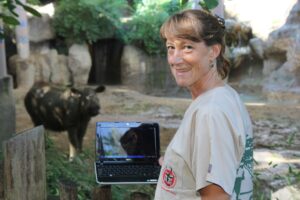
send Harapan to the Sumatran Rhino Sanctuary in Indonesia and transported him there in late October. There he will have the chance to mate and contribute to the survival of his species. It is the end of an era at the Cincinnati Zoo, but a fresh new hope for the Sumatran rhino. The Cincinnati Zoo remains committed to saving the Sumatran rhino by supporting Rhino Protection Units in the wild and continuing to lend support to the breeding program at the Sumatran Rhino Sanctuary.
Join me in a celebration of the milestones achieved by the Zoo’s Sumatran rhino breeding program over the past 30 years, with special thanks to the tireless dedication and commitment of Dr. Terri Roth, her team of CREW scientists, and the rhino keepers.

Sumatran Rhino Breeding Program Timeline
1984 – The Zoo officially formed a partnership (The Sumatran Rhino Trust Agreement) with Indonesia to establish a Sumatran rhino captive breeding program.
1989 – The Zoo received its first Sumatran rhino, a female named Mahatu.
1991 – The Zoo received its first male Sumatran rhino, Ipuh. Unfortunately, initial breeding attempts with Mahatu were unsuccessful and she passed away in 1992.

1995 – The Zoo received a new female Sumatran rhino named Emi.
1996 – CREW scientists initiated research into the reproductive physiology of Sumatran rhinos using endocrinology and ultrasonography.

1997 – The first successful mating was achieved with Emi and Ipuh. Unfortunately, she lost the pregnancy by day 42 of gestation.
1998-1999 – Four additional pregnancies were confirmed by ultrasound; all were lost by three months of gestation.
2000 – A sixth pregnancy was confirmed. This time, Emi was prescribed a hormone supplement.

September 13, 2001 – Success! Emi gave birth to the first Sumatran rhino calf bred and born in captivity in 112 years. He was named Andalas.
July 30, 2004 – Emi gave birth to a second calf, a female named Suci.
February 19, 2007 – Andalas was relocated to the Sumatran Rhino Sanctuary in Indonesia with the goal of breeding with a female there.
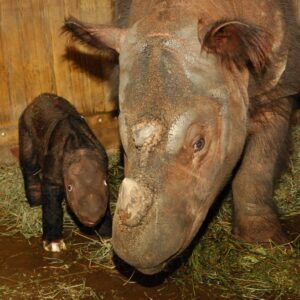
April 29, 2007 – A third calf, a male named Harapan, was born at the Zoo to Emi.
September 5, 2009 – Sadly, Emi passed away due to hemochromatosis, or iron storage disease. Her legacy lives on.
2010 – Andalas bred his mate, Ratu, producing the first pregnancy for the Indonesian breeding program. Unfortunately, Ratu lost her first pregnancy.

2011 – Ratu conceived for the third time and was prescribed the same hormone supplement successfully employed with Emi at the Cincinnati Zoo in the effort to produce Andalas.
June 23, 2012 – Ratu gave birth to a calf named Andatu at the Sumatran Rhino Sanctuary; he is the first captive bred and born Sumatran rhino in Southeast Asia.
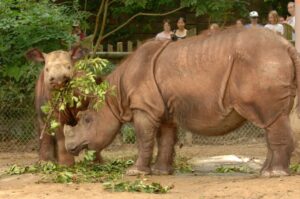
February 2013 – Ipuh passes away from thyroid cancer at the approximate age of 33 years old. He was one of the oldest Sumatran rhinos in captivity.
March 30, 2014 – Sadly, Suci passes away from hemochromatosis, the same iron storage disease that befell her mother. Though Suci never reproduced, she contributed much to the body of knowledge we now have on Sumatran rhino development and maturation.
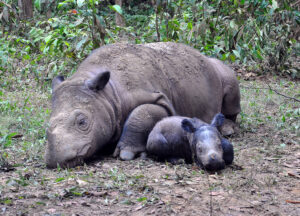
October 2014 – To carry on Ipuh’s legacy, his preserved remains are displayed at the Cincinnati Museum Center as part of the zoology collection.
2014 – The Zoo provided matching funds that contributed to a Debt for Nature deal struck between the United States and Indonesia. In return for lowering debt owed to the United States, Indonesia will commit nearly $12.7 million towards the conservation and protection of critically endangered species, including the Sumatran rhino, and their habitats over the next seven years.
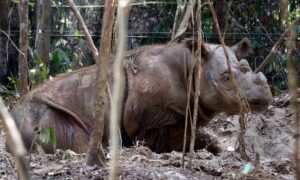
October 2015 – Harapan made his journey from the Cincinnati Zoo to Sumatra. The hope is that he can breed with a female at the Sumatran Rhino Sanctuary and contribute to the survival of his species. Good luck, Harry! Video of Harapan’s journey to Sumatra.

May 2016 – Expected birth date of Andalas and Ratu’s second calf in Indonesia!

